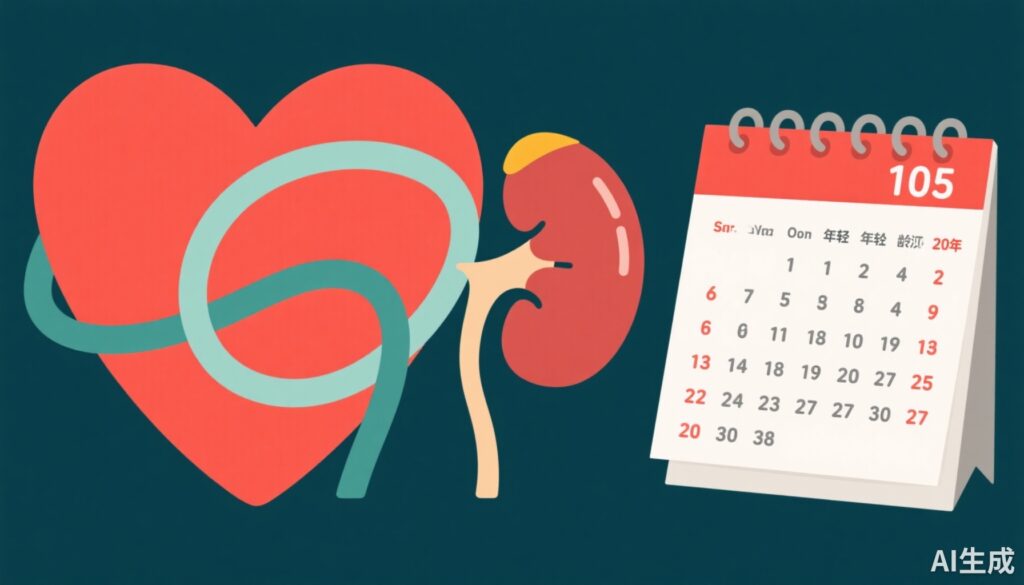Highlight
This large Korean cohort study reveals that maintaining a high cumulative cardiovascular health (CVH) score between ages 30 and 40 is strongly associated with reduced cardiovascular disease (CVD) and chronic kidney disease (CKD) events in midlife. Notably, each 100-point-year increase in CVH corresponds to approximately a one-third reduction in risk for both cardiovascular and kidney outcomes.
This research highlights the value of sustained primordial prevention during young adulthood, as opposed to relying solely on midlife health assessments. It also demonstrates robust associations across sexes and after adjusting for CVH changes or single-time-point scores, emphasizing the importance of cumulative exposure.
Study Background and Disease Burden
Cardiovascular diseases (including myocardial infarction, ischemic stroke, and heart failure) and chronic kidney disease are leading contributors to morbidity and mortality worldwide. Early prevention has increasingly been recognized as essential since vascular and renal damage can begin decades before clinical events. Traditionally, cardiovascular health has been assessed at single time points, often in midlife, to predict risk.
However, this approach may underestimate the impact of sustained cumulative cardiovascular risk factors during young adulthood on later disease onset. The American Heart Association’s Life’s Essential 8 comprises eight modifiable health factors and behaviors that collectively define cardiovascular health, but the association with cumulative exposure over time to these factors remains poorly characterized, especially concerning kidney outcomes.
Study Design
This population-based cohort study utilized data from the Korean National Health Insurance (NHI) health screening and claims databases, including adults aged exactly 40 years without prior CVD or CKD. The cohort consisted of 241,924 participants (78.1% male) who had at least three health examination visits between ages 30 and 40, with a median of eight visits during this period. This enabled robust calculation of the cumulative CVH score over ten years.
The primary exposure was the 10-year cumulative CVH score quantified as the area under the curve (AUC) of CVH scores measured repeatedly from age 30 through 40. The CVH score was scored from 0 to 100 per examination visit, leading to a cumulative range of 0–1000 points-times-years. The composite Life’s Essential 8 metric includes variables such as diet, physical activity, nicotine exposure, sleep health, body mass index, blood lipids, blood glucose, and blood pressure.
Main outcomes evaluated during a median follow-up of 9.2 years after age 40 included cardiovascular events—myocardial infarction, ischemic stroke, heart failure, and cardiovascular mortality—and kidney events, defined as incident CKD, initiation of kidney replacement therapy, or kidney-related death.
Key Findings
During follow-up, 2,748 cardiovascular events and 2,085 kidney events were recorded. Participants in the highest quintile of cumulative CVH score (≥735 points × years) experienced markedly lower annual incidence rates of CVD (0.05%) and kidney events (0.05%) compared to those in the lowest quintile. The adjusted hazard ratios (HR) compared to the lowest quintile were 0.27 (95% CI, 0.22–0.32) for cardiovascular events and 0.25 (95% CI, 0.21–0.31) for kidney events.
Each incremental increase of 100 points × years in cumulative CVH (for example, maintaining a 10-point higher CVH score consistently over 10 years) was associated with a 34% reduction in hazard for cardiovascular events and a 35% reduction for kidney outcomes. These associations were consistent across men and women, across subtypes of cardiovascular disease and kidney endpoints, and remained significant after adjusting for the CVH score at age 40 or the slope of CVH trajectory over the preceding decade.
In essence, this study robustly demonstrates a dose-response relationship between CVH accumulation during young adulthood and subsequent risk, underscoring the vital influence of the early adult cardiovascular environment on middle-age health.
Expert Commentary
This landmark longitudinal study adds important evidence that primordial prevention efforts must commence well before midlife. The concept that a single midlife measurement of cardiovascular health might insufficiently capture lifetime risk exposure is convincingly supported. Given the mechanistic links between endothelial dysfunction, inflammation, and hypertension to both cardiovascular and renal disease, it is biologically plausible that maintaining optimal cardiovascular health early can protect these organs.
A significant strength lies in the large sample size and repeated CVH assessments, enabling a nuanced evaluation of cumulative exposure. However, generalizability beyond the Korean population warrants confirmation, as genetic and lifestyle factors vary internationally. Moreover, despite robust adjustments, observational design precludes absolute causal inference.
These findings align with emerging consensus in guidelines advocating earlier, sustained lifestyle and risk factor control. They also encourage clinicians and policymakers to focus prevention strategies around young adults rather than relying predominantly on midlife intervention.
Conclusion
Maintaining a high cardiovascular health score cumulatively from ages 30 to 40 dramatically lowers risks of premature cardiovascular and kidney events by midlife. This evidence highlights the critical need for ongoing, early primordial prevention targeting lifestyle behaviors and cardiometabolic risk factors during young adulthood. Integrating longitudinal cardiovascular health monitoring into public health and clinical practice could facilitate timely interventions, ultimately mitigating the burden of vascular and renal disease.
Future research should evaluate implementation strategies for sustained lifelong cardiovascular health, explore underlying mechanisms, and validate these findings in diverse populations.
References
Jhee JH, Ha KH, Son D, Lee HH, Kim EJ, Kim HC, Lee H. Cumulative Cardiovascular Health Score Through Young Adulthood and Cardiovascular and Kidney Outcomes in Midlife. JAMA Cardiol. 2025 Oct 1. doi: 10.1001/jamacardio.2025.3269. Epub ahead of print. PMID: 41032326.
American Heart Association. Life’s Essential 8. Updated 2022. https://www.heart.org/en/healthy-living/healthy-lifestyle/lifes-essential-8
Moussa I, et al. Primordial prevention of cardiovascular disease: Time for a paradigm shift. J Am Heart Assoc. 2022;11(6):e023561.
Levey AS, et al. Chronic Kidney Disease. Lancet. 2020;395(10225):1250-1262.



